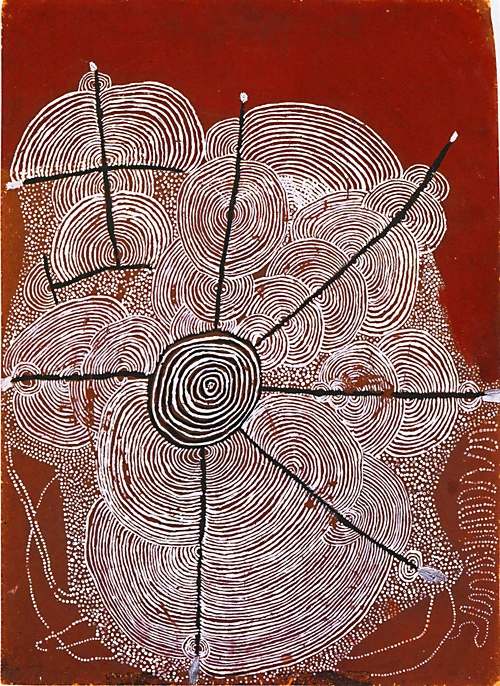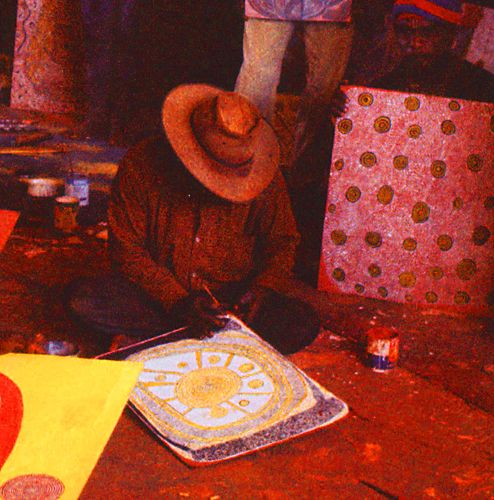
Children’s Water Dreaming 1972, 62 x 44 cm, Shorty Lungkarta Tjungurrayi
Aborigines used Australia’s wealth in ochre colors (iron oxides) to paint their mythologies on sand, cut bark of stringybark tree and their bodies. In 1972, acrylic paints and masonite boards were made available to a few Aboriginal men congregating in a ‘painting club’. While the usage of contemporary materials served to adulterate, it also helped to popularize Australian Aboriginal art.

Classic Pintupi Water Dreaming 1972, 62 x 42 cm, Shorty Lungkarta Tjungurrayi
Last year, early ‘Papunya’ boards were shown at the Grey Art Gallery, NYU. Paintings from the exhibition are reproduced in a book icons of the desert that also provides anthropological information on Aboriginal art and artists.

Shorty Lungkarta Tjungurrayi, detail of a group portrait, Men’s painting room, Papunya, 1972
Shorty Lungkarta Tjungurrayi, then 52 yr old, was a member of the 1972 painting club. In his ‘Water Dreamings’, he painted the distant region of his youth. Water Dreamings can be openly shown unlike secret men mythologies that were displayed during the NYC exhibition in a separate room. At the entrance, a message warned Aboriginal women not to enter there. These secret boards are reproduced in a separate, removable folder within icons of the desert. (Women, too, possess secret mythologies).
Researching classical pigments, a British journalist visited Australia on her quest for ochre. In her book COLOR, a Natural History of the Palette she writes about contemporary Australian Aboriginal painters, many of whom are women. She also visited the schoolteacher who created the 1972 painting club and thereby provided the impetus for popularizing Australian Aboriginal art.
An explanation of Dreaming is given in COLOR, a Natural History of the Palette
Traditional Aboriginal life only makes sense in the context of the time when Ancestors first arose out of the original mud or sea or sky and brought the first sunrise with them. In English it is articulated as the “Dreaming” or “Dreamtime” – a dream in the sense that it is not set in the past, but a kind of parallel present universe, rather like the one that we operate in while we are asleep. In Aboriginal lore, the Dreaming is the reason for everything that has ever existed and ever will exist. And its stories are told in layers, depending on how ready, or authorized, the listener is to understand them. It is said that your personal Dreaming depends on where your mother was when she first felt you in the womb. The Ancestors who live in that place have given you “anima” – they have animated you – and when you grow up their stories and songs will be in your trust, and you in theirs.

The paintings look trance-like. Are the artists in some kind of a meditative/trance state as they create them?
I also notice that the painting the artist is working on in the portrait is nearly identical to one posted above it, was that intentional? And, is this a common design?
I especially enjoy the Children’s Water Dreaming piece.
Tree,
With respect to a trance-like state of the artist, all I read was that Shorty was very ‘focused’ when he painted.
During the exhibition, the yellow painting captivated me. But having ‘lived’ with the reproductions in icons of the desert , I am also more moved by the Children’s Water Dreaming. Looking at it makes me feel good – magic. I bought the book in October, intending to do a post on it. But somehow, I could not bring myself to share it until now.
In the group photo, Shorty is indeed working on the Classic Pintupi Water Dreaming. None of the other Papunya board showed that much yellow. Each design appears to be unique.
I agree, magic.
Years ago, I came across a magazine article on Transcendental Art. It used dots to create basic shapes like triangles, circles, etc. using a limited palette (at least the ones featured in the article). They remind me a bit of these aboriginal works and now I want to study up on the Transcendental Art to see if there’s an intentional connection.
Steve, thanks for adding the edit feature but I’m afraid it’s not working for me. I get a message basically telling me the comment doesn’t exist.
Tree,
It is not easy to find out about transcendental art. Googling for images brings up much kitsch. Googling for info brings up gurus who want to show you their path to the light. Amazon.com does not seem to sell books on that topic.
It seems difficult to find the kind of information that you alluded to – elusive
Yes. Interesting, isn’t it? :-)
Years ago, I cut out the art images from the above mentioned magazine and I still have them. Maybe it was just a very quick art movement? Hard to say and I’m not help as I have no names or locations.
Tree,
It would be great seeing the pictures that you cut out. Could you make a post with them?
I’d have to get my hands on a color scanner. I’ll see what I can do.
Birgit,
Aboriginal paintings have been fascinating for me (see end of this post), and also an influence on David’s work. Aside from their visual appeal, it is their connection to real places, places that must not be forgotten, that is particularly compelling.
I wonder what a semi-symbolic map of your dune country would look like, if you painted one along these lines.
Steve,
For a moment, I felt crazy when your post from July 22, 2008 propelled me to a post about aboriginal art, October 8, 2009. Is that what a time shift feels like?
...it is their connection to real places…that is particularly appealing! I think that way too. Maybe my Sleeping Bear Dunes painting Unfinished picture 2 was a start, a painting that Troels stopped me from finishing, to depict a place symbolically?
To present a place symbolically, does it necessarily mean to abstract it?
Searching for the Dune painting mentioned above on A&P, I came across my Greenwich Village photograph that, to me, is symbolic of intricacy/absurdity of the Village and of the people living and visiting there.
David, if you’re there…
TRYSTERO includes the smoke pattern of the first shuttle disaster. Gotta be.
By coincidence I’m touching up some of my map paintings. I’ll throw together a little post.
Together with the aboriginal art that we’re discussing is the latticework employed by Polynesian sailors to guide them on their ways about the Pacific Ocean.
Birgit,
I find it somewhat hard to cleanly distinguish symbolism and abstraction. For me, symbolism based on conventional metaphors is usually rather uninteresting, whereas abstraction based on “natural” metaphorical associations is very intriguing. But if the conventional metaphor seems to also have a truly personal meaning for the artist, then it works better.
Jay,
Quite right about the smoke allusion. I’m not sure how Crying of Lot 49 comes into it, other than general conspiracy reference …
There’s a real sense in which the aboriginal paintings are maps–they’re more than “merely” symbolic. So I’m very curious to see your map paintings.
“David, if you’re there…”
I wasn’t, but I’m finally checking in.
Jay, yes, to the Challenger smoke pattern.
Steve, the black thistle reminds me somewhat of the silent black-clad assassins w/ their daggers. Also, could the space shuttle program be the precursor to an interplanetary postal system? Unwanted competition?
Birgit, thanks for posting this. I love this work, especially the acrylic paintings from the 70s onward. We have a small one in our apartment, by a female Aboriginal artist.
Jay, the Challenger smoke pattern is also used in Babel.
http://davidpalmerstudio.com/FAF/Babel_large.html
Hello:
Just thought I’d break the silence.
Hi Jay,
I just started painting again and having fun. Perhaps, I will have a snow picture to show by next week.
I have a show opening tonight. Hopefully more time after that…
Steve:
Congratulations. Hope it’s a big success.
Libraries seem to be the place where. I may have indicated that I have a show at the library down at the end of the block.
Congratulation, Steve and Jay.
Never having had a show, I am eager to learn about the process. Please do posts on how you prepared and what happened at your shows.
Birgit:
I assume that you are referring to the same thing with painting and having fun.
The show has been up for a week or so and I should allow it to fester on a bit before posting a report. Suffice it to say that there have been challenges. It appears that June has something in the works and she might want to jump in.
I’m with Birgit, I’d love to read Jay and Steve’s show experiences. Congratulations to you both.
And speaking of writing, I have every intention of writing something on the above mentioned “transcendental art” as soon as I can.